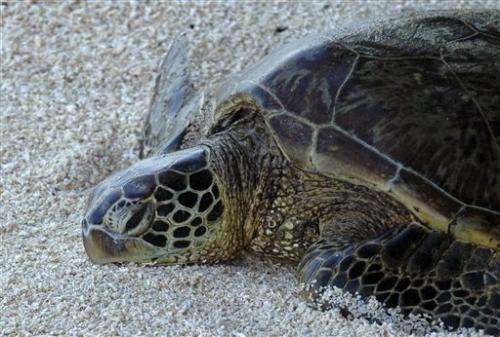US agency: Keep threatened status for green sea turtles

Hawaii's green sea turtles should continue to be classified as threatened because its population is small and nearly all of them nest at the same low-lying atoll, federal wildlife agencies said Friday.
The Association of Hawaiian Civic Clubs petitioned the government in 2012 to study whether Hawaii's green sea turtles might have recovered to the point where they no longer need Endangered Species Act protections.
But Patrick Opay, the endangered species branch chief of NOAA's Fisheries Pacific Islands Regional Office, said Hawaii has fewer than 4,000 nesting green sea turtles, and 96 percent of them nest at French Frigate Shoals in the Northwestern Hawaiian Islands.
This makes them vulnerable to outbreaks of disease, rising sea levels and other threats, Opay said. "You have all of your eggs in one basket, so to speak," he said.
Green sea turtles nest on beaches and feed in the ocean, eating mostly seagrass and algae. Adult females return to the same beaches where they were born every two to four years to lay eggs, sometimes migrating hundreds or thousands of miles.
The Association of Hawaiian Civic Clubs said at the time of its petition that delisting Hawaii's turtles would return management of the animals to the state and allow more people in the islands to take an active role in taking care of them.
The association cited 2007 data showing Hawaii's population of green sea turtles had been growing at an annual rate of 5.7 percent for three decades. The latest review showed a 4.8 percent annual growth rate.
Annelle Amaral, the association's president, said the group is disappointed the agencies aren't proposing to delist the population.
She said people who fish, harvest seaweed and otherwise rely on the ocean to feed their families tell her number of turtles has grown so much the animals are moving inland—to places like the Hanalei River—to forage for food. She's heard some areas are overpopulated with turtles, known as honu in Hawaiian.
NOAA and the U.S. Fish and Wildlife Service studied green sea turtle populations around the world as part of the review. The research prompted them to propose designating 11 distinct populations of the animals, including one in Hawaii.
They found separate populations of turtles in Florida and Mexico have recovered to the point that they proposed categorizing them as threatened instead of endangered.
But the agencies believe turtles in American Samoa and the Northern Mariana Islands, which were considered threatened before, should now be classified as endangered.
The agencies will be accepting public comment on their proposals for the next three months. They are scheduled to host a public hearing in Honolulu on April 8.
© 2015 The Associated Press. All rights reserved.



















